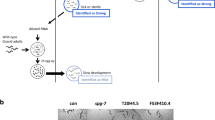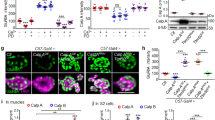Abstract
Necrotic cell death underlies the pathology of numerous human neurodegenerative conditions1. In the nematode Caenorhabditis elegans, gain-of-function mutations in specific ion channel genes such as the degenerin genes deg-1 and mec-4, the acetylcholine receptor channel subunit gene deg-3 and the Gs protein α-subunit gene gsa-1 evoke an analogous pattern of degenerative (necrotic-like) cell death in neurons that express the mutant proteins2,3,4,5,6. An increase in concentrations of cytoplasmic calcium in dying cells, elicited either by extracellular calcium influx or by release of endoplasmic reticulum stores, is thought to comprise a major death-signalling event7,8. But the biochemical mechanisms by which calcium triggers cellular demise remain largely unknown. Here we report that neuronal degeneration inflicted by various genetic lesions in C. elegans requires the activity of the calcium-regulated CLP-1 and TRA-3 calpain proteases and aspartyl proteases ASP-3 and ASP-4. Our findings show that two distinct classes of proteases are involved in necrotic cell death and suggest that perturbation of intracellular concentrations of calcium may initiate neuronal degeneration by deregulating proteolysis. Similar proteases may mediate necrotic cell death in humans.
This is a preview of subscription content, access via your institution
Access options
Subscribe to this journal
Receive 51 print issues and online access
$199.00 per year
only $3.90 per issue
Buy this article
- Purchase on Springer Link
- Instant access to full article PDF
Prices may be subject to local taxes which are calculated during checkout




Similar content being viewed by others
References
Syntichaki, P. & Tavernarakis, N. Death by necrosis: uncontrollable catastrophe, or is there order behind the chaos? EMBO Rep. 3, 604–609 (2002)
Chalfie, M. & Wolinsky, E. The identification and suppression of inherited neurodegeneration in Caenorhabditis elegans. Nature 345, 410–416 (1990)
Driscoll, M. & Chalfie, M. The mec-4 gene is a member of a family of Caenorhabditis elegans genes that can mutate to induce neuronal degeneration. Nature 349, 588–593 (1991)
Treinin, M. & Chalfie, M. A mutated acetylcholine receptor subunit causes neuronal degeneration in C. elegans. Neuron 14, 871–877 (1995)
Korswagen, H. C., Park, J. H., Ohshima, Y. & Plasterk, R. H. An activating mutation in a Caenorhabditis elegans Gs protein induces neural degeneration. Genes Dev. 11, 1493–1503 (1997)
Berger, A. J., Hart, A. C. & Kaplan, J. M. Gαs-induced neurodegeneration in Caenorhabditis elegans. J. Neurosci. 18, 2871–2880 (1998)
Sattler, R. & Tymianski, M. Molecular mechanisms of calcium-dependent excitotoxicity. J. Mol. Med. 78, 3–13 (2000)
Xu, K., Tavernarakis, N. & Driscoll, M. Necrotic cell death in C. elegans requires the function of calreticulin and regulators of Ca2+ release from the endoplasmic reticulum. Neuron 31, 957–971 (2001)
Hall, D. H. et al. Neuropathology of degenerative cell death in Caenorhabditis elegans. J. Neurosci. 17, 1033–1045 (1997)
Lee, J. M., Zipfel, G. J. & Choi, D. W. The changing landscape of ischaemic brain injury mechanisms. Nature 399, A7–A14 (1999)
Chung, S., Gumienny, T. L., Hengartner, M. O. & Driscoll, M. A common set of engulfment genes mediates removal of both apoptotic and necrotic cell corpses in C. elegans. Nature Cell Biol. 2, 931–937 (2000)
Jacobson, L. A. et al. Identification of a putative structural gene for cathepsin D in Caenorhabditis elegans. Genetics 119, 355–363 (1988)
Rogalski, T. M., Mullen, G. P., Bush, J. A., Gilchrist, E. J. & Moerman, D. G. UNC-52/perlecan isoform diversity and function in Caenorhabditis elegans. Biochem. Soc. Trans. 29, 171–176 (2001)
Estevez, M. et al. The daf-4 gene encodes a bone morphogenetic protein receptor controlling C. elegans dauer larva development. Nature 365, 644–649 (1993)
Hawdon, J. M., Emmons, S. W. & Jacobson, L. A. Regulation of proteinase levels in the nematode Caenorhabditis elegans. Preferential depression by acute or chronic starvation. Biochem. J. 264, 161–165 (1989)
Tcherepanova, I., Bhattacharyya, L., Rubin, C. S. & Freedman, J. H. Aspartic proteases from the nematode Caenorhabditis elegans. Structural organization and developmental and cell-specific expression of asp-1. J. Biol. Chem. 275, 26359–26369 (2000)
Tavernarakis, N., Wang, S. L., Dorovkov, M., Ryazanov, A. & Driscoll, M. Heritable and inducible genetic interference by double-stranded RNA encoded by transgenes. Nature Genet. 24, 180–183 (2000)
Miura, M., Zhu, H., Rotello, R., Hartwieg, E. A. & Yuan, J. Induction of apoptosis in fibroblasts by IL-1 beta-converting enzyme, a mammalian homolog of the C. elegans cell death gene ced-3. Cell 75, 653–660 (1993)
Tavernarakis, N., Shreffler, W., Wang, S. & Driscoll, M. unc-8, a DEG/ENaC family member, encodes a subunit of a candidate mechanically gated channel that modulates C. elegans locomotion. Neuron 18, 107–119 (1997)
Sorimachi, H. & Suzuki, K. The structure of calpain. J. Biochem. (Tokyo) 129, 653–664 (2001)
Yamashima, T. Implication of cysteine proteases calpain, cathepsin and caspase in ischemic neuronal death of primates. Prog. Neurobiol. 62, 273–295 (2000)
Barnes, T. M. & Hodgkin, J. The tra-3 sex determination gene of Caenorhabditis elegans encodes a member of the calpain regulatory protease family. EMBO J. 15, 4477–4484 (1996)
Sokol, S. B. & Kuwabara, P. E. Proteolysis in Caenorhabditis elegans sex determination: cleavage of TRA-2A by TRA-3. Genes Dev. 14, 901–906 (2000)
Adamec, E., Mohan, P. S., Cataldo, A. M., Vonsattel, J. P. & Nixon, R. A. Up-regulation of the lysosomal system in experimental models of neuronal injury: implications for Alzheimer's disease. Neuroscience 100, 663–675 (2000)
Ferri, K. F. & Kroemer, G. Organelle-specific initiation of cell death pathways. Nature Cell Biol. 3, E255–E263 (2001)
Stracher, A. Calpain inhibitors as therapeutic agents in nerve and muscle degeneration. Ann. NY Acad. Sci. 884, 52–59 (1999)
Huang, Y. & Wang, K. K. The calpain family and human disease. Trends Mol. Med. 7, 355–362 (2001)
Brenner, S. The genetics of Caenorhabditis elegans. Genetics 77, 71–94 (1974)
Fire, A. et al. Potent and specific genetic interference by double-stranded RNA in Caenorhabditis elegans. Nature 391, 806–811 (1998)
Kamath, R. S., Martinez-Campos, M., Zipperlen, P., Fraser, A. G. & Ahringer, J. Effectiveness of specific RNA-mediated interference through ingested double-stranded RNA in Caenorhabditis elegans. Genome Biol. 2, research0002.1–0002.10 (2001)
Acknowledgements
We thank P. Kuwabara and S. Sokol for communicating results before publication; C. Samara for technical help; and colleagues for discussions and comments on the manuscript. Some nematode strains used in this work were provided by the Caenorhabditis Genetics Center, which is funded by the NIH National Center for Research Resources. Certain strains were from the NemaPharm Group of Axys Pharmaceuticals. We thank A. Fire for plasmid vectors and L. Jacobson for cad-1 mutant strains. This work was funded in part by grants from NIH NINDS to M.D. and by grants from HFSPO and IMBB to N.T.
Author information
Authors and Affiliations
Corresponding author
Ethics declarations
Competing interests
The authors declare that they have no competing financial interests.
Supplementary information
Rights and permissions
About this article
Cite this article
Syntichaki, P., Xu, K., Driscoll, M. et al. Specific aspartyl and calpain proteases are required for neurodegeneration in C. elegans. Nature 419, 939–944 (2002). https://doi.org/10.1038/nature01108
Received:
Accepted:
Issue Date:
DOI: https://doi.org/10.1038/nature01108
This article is cited by
-
A guide to cell death pathways
Nature Reviews Molecular Cell Biology (2023)
-
Proteomic profiling of hydatid fluid from pulmonary cystic echinococcosis
Parasites & Vectors (2022)
-
Differential regulation of degradation and immune pathways underlies adaptation of the ectosymbiotic nematode Laxus oneistus to oxic-anoxic interfaces
Scientific Reports (2022)
-
Olfactory receptor neurons express olfactory marker protein but not calpain 5 from the same genomic locus
Molecular Brain (2019)
-
Cationic gold nanoparticles elicit mitochondrial dysfunction: a multi-omics study
Scientific Reports (2019)
Comments
By submitting a comment you agree to abide by our Terms and Community Guidelines. If you find something abusive or that does not comply with our terms or guidelines please flag it as inappropriate.



